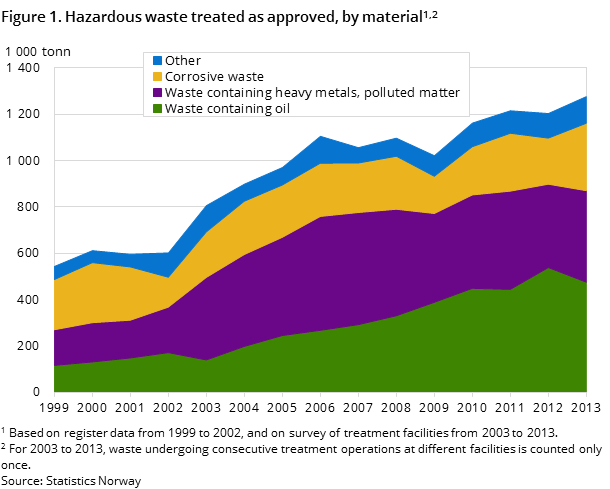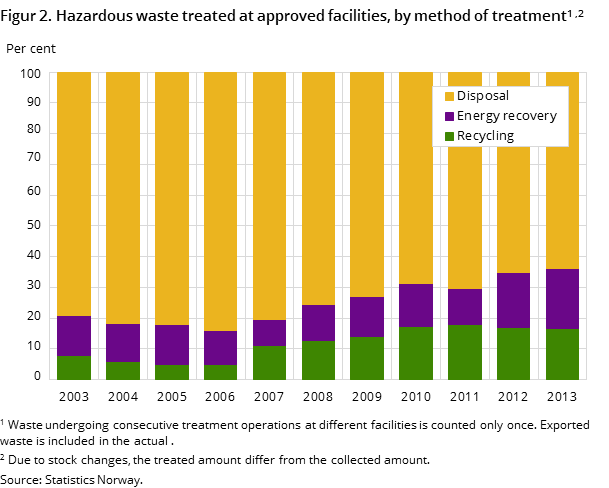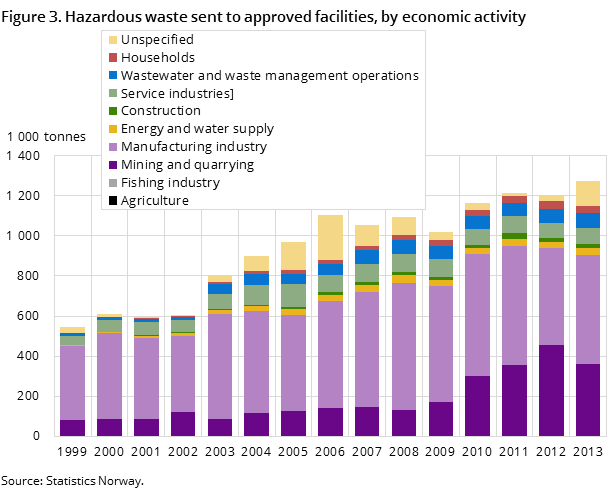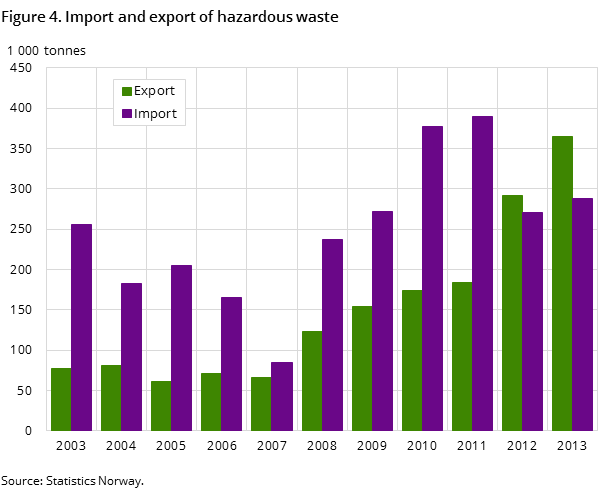Content
Published:
This is an archived release.
1.3 million tonnes of hazardous waste
A total of 1.3 million tonnes of hazardous waste were sent for approved treatment in 2013. This constitutes a 6 per cent increase compared to the year before. Since the statistics started in 1999, the amount of hazardous waste has increased by 135 per cent.
| 2013 | 2012 | 2009 | Change in per cent | ||
|---|---|---|---|---|---|
| 2012 - 2013 | 2009 - 2013 | ||||
| Total | 1 276 | 1 203 | 1 021 | 6.1 | 25.0 |
| Waste containing oil | 475 | 538 | 389 | -11.7 | 22.1 |
| Waste containing solvents | 32 | 31 | 27 | 3.2 | 18.5 |
| Other organic waste | 34 | 33 | 17 | 3.0 | 100.0 |
| Waste containing heavy metals, polluted matter | 395 | 360 | 383 | 9.7 | 3.1 |
| Corrosive waste | 291 | 199 | 161 | 46.2 | 80.7 |
| Other inorganic hazardous wastes | 10 | 8 | 5 | 25.0 | 100.0 |
| Processing water | 38 | 34 | 32 | 11.8 | 18.8 |
| Photo chemicals | 1 | 1 | 1 | 0.0 | 0.0 |
| Nonclassified hazardous waste | 1 | 0 | 7 | . | -85.7 |




Hazardous waste contains both health and environmentally hazardous substances. Thus, it is a prioritised political goal that as much as possible of the hazardous waste is subject to proper treatment in order to avoid harming people and the environment.
95 per cent to approved treatment
The statistics provide figures for the amounts of hazardous waste sent for approved treatment, but also estimated amounts to unknown treatment. Unknown treatment means that the waste has not been properly registered by an authorised facility, and for 2013 this amount totalled 70 000 tonnes. Taking into consideration that 1.3 million tonnes was subjected to approved treatment, it follows that 95 per cent of hazardous waste was treated at approved facilities, according to estimations. This is around the same level as the year before.
Around 37 per cent of the approved waste treatment was recovered, i.e. either recycled (17 per cent) or energy recovered (20 per cent). The remaining 64 per cent was disposed of, which mainly entails the waste being stabilised through chemical or physical pre-treatment and stored at specially-designed landfills. Treatment abroad is included in these figures, but stock changes are not.
Further increase in export of hazardous waste
There has been a noticeable increase in exported amounts of hazardous waste in recent years. In 2013, Norway sent 365 000 tonnes out of the country for treatment abroad; an increase of 25 per cent compared to the year before. Simultaneously, Norway imported 290 000 tonnes of hazardous waste from abroad; up 6 per cent compared to the year before.
Imports are dominated by waste containing heavy metals and polluted mineral matter destined for landfilling in Norway. Exports, on the other side, are mainly made up of various types of oil-containing hazardous waste, process water and heavy metal-containing waste.
The import and export of hazardous waste requires approval from the authorities in order to ensure proper treatment in the receiving country.
Oil and heavy metal-containing waste dominate
Oil-containing waste – totalling 475 000 tonnes – makes up the largest fraction of hazardous waste in 2013. This includes, among other things, waste from oil drilling activities on the Norwegian shelf. The second largest is heavy metal-containing waste, totalling 395 000 tonnes. The majority of this was slag from manufacturing, but also CCA-impregnated wood, batteries and used sand from grit blasting.
540 000 tonnes from manufacturing
Manufacturing industries sent 540 000 tonnes of hazardous waste for approved treatment in 2013, including treatment in their own facilities. This makes up around 42 per cent of all hazardous waste in Norway. Another main contributor - with almost 360 000 tonnes - is the mining and quarrying industry, which includes oil extraction activities.
Households accounted for around 37 000 tonnes of hazardous waste sent for approved treatment in 2013. Impregnated wood, paint residues and waste oil constitute the main components.
Less hazardous waste from Svalbard
The amount of hazardous waste from Svalbard varies from year to year. In recent years, between 100 and 300 tonnes of hazardous waste have been sent annually for approved treatment. In 2013, the amount was 80 tonnes, of which almost 74 per cent was made up of oil-containing waste. Hazardous waste from Svalbard is transported to the mainland for treatment there.
Additional information
Approved treatment as applied in this article includes only hazardous waste generated in Norway (export is therefore included, while import is excluded).
Contact
-
Gisle Berge
E-mail: gisle.berge@ssb.no
tel.: (+47) 48 12 19 97
-
Terje Lorentzen Landsem
E-mail: terje.landsem@ssb.no
tel.: (+47) 98 84 31 39
